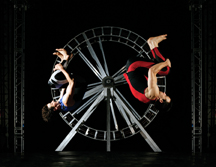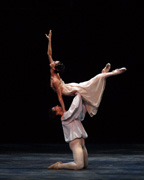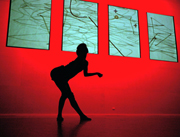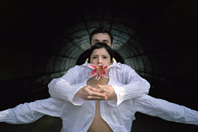this week's reviews
Letter from New York
Lincoln Center Festival
by Nancy Dalva
Letter from London
Birmingham Royal Ballet, London Studio Centre, Ballet Central,
and Mark Morris's "King Arthur" for the English National Opera
by John Percival
Vishneva and Corella in ABT's "Romeo and Juliet"
by Michael Popkin
Chunky Move
by Lisa Rinehart
Dušan Týnek
by Susan Reiter
Letters and Commentary
Letter from New York:
The Lincoln Center Festival — Opening Week
by Nancy Dalva
Letter from London
Birmingham Royal Ballet, London Studio Centre, Ballet Central,
and Mark Morris's "King Arthur" for the English National Opera
by John Percival
San Francisco Letter No. 12
Migrations, RHJ/Pronounced Ridge
by Rita Felciano
Bulletin from Berlin 1
by George Jackson
Bulletin from Berlin 2
by George Jackson
did you miss any of these?
Lincoln Center Festival 2004
The Ashton Celebration
The Royal Ballet's New "Sleepiing Beauty"
by John Percival
ABT's "Sylvia":
Amor Vincit Omnia
by Mary Cargill
ABT's "Sylvia": Ashton-esque
by Leigh Witchel
David Hallberg's debut in "Sylvia"
by Susan Reiter
Veronika Part and Marcelo Gomes in "Swan Lake"
by Gay Morris
Scott Wells at Counterpulse
by Paul Parish
Aszure Barton at the Pillow
by Susan Reiter
what we're reading
Robert Gottlieb on the Royal Ballet's new "Beauty," and Alina Cojocaru, in The New York Observer
Joan Acocella on ABT's Spring Met Season, for The New Yorker
Rethinking the Composer-Choreographer Contract: Deborah Jowitt for The Village Voice
Ismene Brown on the background behind the Kirov and Bolshoi seasons in London, for The Telegraph
Tobi Tobias interviews Julie Kent for Bloomberg News
Letter from New York
The Lincoln Center Festival — Opening Week
Streb vs Gravity (World Premiere);
Grendel;
Druid Synge;
Symposium: Expanding Dance
with Elizabeth Streb, David Gordon,
Yvonne Rainer, and Jennifer Tipton;
Gat
by Nancy Dalva
 Hot, hot, hot. Hell, hell, hell. The world overheated and exploding, the city overheated and, on one block between Madison and Park Avenues, exploded. But this: the plaza at Lincoln Center filled with the marvelous music of Midsummer Night Swing, with couples dancing all over the place, and every constituent theater — and three more annexed for the occasion — filled with dance, theater, opera, and somehow, marvelously, world enough and time not merely to take it in, but to talk about it, to appreciate the very endeavor of creativity, and respond. In other words, festival as think tank: a place to fill up your mind, your eye, and refuel for whatever comes next. High octane, and essential. If I didn’t live here, I would come here for this. At the front of the plaza, to the left, you will see as you enter a huge sculpture apparently formed of water craft, hovering overhead like a space ship. Find whatever metaphor in this you like — or just look up, and laugh. READ MORE
Hot, hot, hot. Hell, hell, hell. The world overheated and exploding, the city overheated and, on one block between Madison and Park Avenues, exploded. But this: the plaza at Lincoln Center filled with the marvelous music of Midsummer Night Swing, with couples dancing all over the place, and every constituent theater — and three more annexed for the occasion — filled with dance, theater, opera, and somehow, marvelously, world enough and time not merely to take it in, but to talk about it, to appreciate the very endeavor of creativity, and respond. In other words, festival as think tank: a place to fill up your mind, your eye, and refuel for whatever comes next. High octane, and essential. If I didn’t live here, I would come here for this. At the front of the plaza, to the left, you will see as you enter a huge sculpture apparently formed of water craft, hovering overhead like a space ship. Find whatever metaphor in this you like — or just look up, and laugh. READ MORE
Letter from London
Birmingham Royal Ballet, London Studio Centre, Ballet Central,
and Mark Morris's "King Arthur" for the English National Opera
by John Percival
 Historical sense – what’s that? Well, for a start it’s something that ballet directors tend conspicuously to lack. Take the Royal Ballet for instance. After a glut of centennial Ashton, we’re doomed next season to go back to largely ignoring him. And when choosing dances to celebrate the company’s 75th birthday, one of its greatest choreographic discoveries, John Cranko, was almost omitted, while naturally Antony Tudor’s creations were entirely left out. Thank heaven for David Bintley’s regime at Birmingham Royal Ballet, where despite his determination to concentrate on creativity, he has made time also to restore some works by Ashton and de Valois that were long thought lost. Just now, too, for two simultaneous small-town tours, he has revived Cranko’s “Brouillards” and “Pineapple Poll” in the north-east and mounted Tharp’s “Sinatra Songs” in the south-west (I wish I could have seen them). But BRB’s programmes are a rare exception, which is one reason why we look forward each year to the “Images of Dance” tour by senior ballet students of the London Studio Centre, since artistic director Margaret Barbieri has a flair for choosing interesting programmes. READ MORE
Historical sense – what’s that? Well, for a start it’s something that ballet directors tend conspicuously to lack. Take the Royal Ballet for instance. After a glut of centennial Ashton, we’re doomed next season to go back to largely ignoring him. And when choosing dances to celebrate the company’s 75th birthday, one of its greatest choreographic discoveries, John Cranko, was almost omitted, while naturally Antony Tudor’s creations were entirely left out. Thank heaven for David Bintley’s regime at Birmingham Royal Ballet, where despite his determination to concentrate on creativity, he has made time also to restore some works by Ashton and de Valois that were long thought lost. Just now, too, for two simultaneous small-town tours, he has revived Cranko’s “Brouillards” and “Pineapple Poll” in the north-east and mounted Tharp’s “Sinatra Songs” in the south-west (I wish I could have seen them). But BRB’s programmes are a rare exception, which is one reason why we look forward each year to the “Images of Dance” tour by senior ballet students of the London Studio Centre, since artistic director Margaret Barbieri has a flair for choosing interesting programmes. READ MORE
American Ballet Theatre at the Met
Vishneva and Corella in "Romeo and Juliet"
by Michael Popkin
 This Spring has been Diana Vishneva’s season at ABT. Not only her devoted fans, but many critics, as well, have been effusive in their praise of her. Whenever Vishneva appears, ABT nearly sells out New York’s huge Metropolitan Opera House, its home during the Spring season. That was the case Monday night. There was a palpable sense of excitement in the air when ABT opened the final week of its Spring season in New York to a packed house for its first performance of MacMillan’s “Romeo and Juliet” with Vishneva and Angel Corella in the title roles and a supporting cast that included (among others) Herman Cornejo as Mercutio, David Hallberg as Paris, Gennadi Saveliev as Tybalt, Veronica Part as Lady Capulet, Sacha Radetsky as Benvolio, and the venerable Frederic Franklin as Friar Laurence. There is no question that Vishneva is a star performer, but some of the very things that constitute her great appeal work against her as Juliet. READ MORE
This Spring has been Diana Vishneva’s season at ABT. Not only her devoted fans, but many critics, as well, have been effusive in their praise of her. Whenever Vishneva appears, ABT nearly sells out New York’s huge Metropolitan Opera House, its home during the Spring season. That was the case Monday night. There was a palpable sense of excitement in the air when ABT opened the final week of its Spring season in New York to a packed house for its first performance of MacMillan’s “Romeo and Juliet” with Vishneva and Angel Corella in the title roles and a supporting cast that included (among others) Herman Cornejo as Mercutio, David Hallberg as Paris, Gennadi Saveliev as Tybalt, Veronica Part as Lady Capulet, Sacha Radetsky as Benvolio, and the venerable Frederic Franklin as Friar Laurence. There is no question that Vishneva is a star performer, but some of the very things that constitute her great appeal work against her as Juliet. READ MORE
Men's Studies
by Lisa Rinehart
 Chunky Move's director, Gideon Obarzanek, likes to tell stories, or, perhaps more accurately, he likes to tell us the stories behind the story. With "I Want to Dance Better at Parties," he's moved from the abstract darkness of last year's "Tense Dave" to a docudance exploring the importance of social dance in the lives of five Australian men. Projections of the men dancing — each in markedly different styles — float across five large suspended screens as the men tell us why they dance (or in one case, why they don't). One of the piece's six dancers (the excellent Kristy Ayre, Anthony Hamilton, Jo Lloyd, Lee Serle, Delia Silvan and Adam Wheeler) demonstrates a slicker version of the mens' moves and we quickly learn that our subjects are a diverse bunch. There's Philip, a recently widowed father with a curiosity about Latin dance, Jack, a retired engineer with a passion for Israeli dances, Dimosthenis, comfortable in the male milieu of Greek social dancing, Lindsay, a gay clog dancer, and Franc, a composer flummoxed by his inability to move. Obarzanek picks apart the facades of these not so average Joe's and shows us what we already suspect: everyone has a story to tell and it's usually quite different from what is articulated. READ MORE
Chunky Move's director, Gideon Obarzanek, likes to tell stories, or, perhaps more accurately, he likes to tell us the stories behind the story. With "I Want to Dance Better at Parties," he's moved from the abstract darkness of last year's "Tense Dave" to a docudance exploring the importance of social dance in the lives of five Australian men. Projections of the men dancing — each in markedly different styles — float across five large suspended screens as the men tell us why they dance (or in one case, why they don't). One of the piece's six dancers (the excellent Kristy Ayre, Anthony Hamilton, Jo Lloyd, Lee Serle, Delia Silvan and Adam Wheeler) demonstrates a slicker version of the mens' moves and we quickly learn that our subjects are a diverse bunch. There's Philip, a recently widowed father with a curiosity about Latin dance, Jack, a retired engineer with a passion for Israeli dances, Dimosthenis, comfortable in the male milieu of Greek social dancing, Lindsay, a gay clog dancer, and Franc, a composer flummoxed by his inability to move. Obarzanek picks apart the facades of these not so average Joe's and shows us what we already suspect: everyone has a story to tell and it's usually quite different from what is articulated. READ MORE
Dušan Týnek
by Susan Reiter
 Clarity of vision and an overlay of luminous melancholy were evident in the two substantial world premieres offered by the Czech-born Dušan Týnek, who has been attracting considerable critical enthusiasm since he formed his company in 2003. This was my introduction to his choreography, and while the program was thoughtful and cleanly crafted, the movement invention remained somewhat earthbound, especially in relation to the sensuously eloquent music to which he set his works. Occasional unpredictable twists or moments of delicious strangeness made one sit up and take notice, indicating a potential for breaking free and going beyond the generally efficient tone. READ MORE
Clarity of vision and an overlay of luminous melancholy were evident in the two substantial world premieres offered by the Czech-born Dušan Týnek, who has been attracting considerable critical enthusiasm since he formed his company in 2003. This was my introduction to his choreography, and while the program was thoughtful and cleanly crafted, the movement invention remained somewhat earthbound, especially in relation to the sensuously eloquent music to which he set his works. Occasional unpredictable twists or moments of delicious strangeness made one sit up and take notice, indicating a potential for breaking free and going beyond the generally efficient tone. READ MORE
 Hot, hot, hot. Hell, hell, hell. The world overheated and exploding, the city overheated and, on one block between Madison and Park Avenues, exploded. But this: the plaza at Lincoln Center filled with the marvelous music of Midsummer Night Swing, with couples dancing all over the place, and every constituent theater — and three more annexed for the occasion — filled with dance, theater, opera, and somehow, marvelously, world enough and time not merely to take it in, but to talk about it, to appreciate the very endeavor of creativity, and respond. In other words, festival as think tank: a place to fill up your mind, your eye, and refuel for whatever comes next. High octane, and essential. If I didn’t live here, I would come here for this. At the front of the plaza, to the left, you will see as you enter a huge sculpture apparently formed of water craft, hovering overhead like a space ship. Find whatever metaphor in this you like — or just look up, and laugh. READ MORE
Hot, hot, hot. Hell, hell, hell. The world overheated and exploding, the city overheated and, on one block between Madison and Park Avenues, exploded. But this: the plaza at Lincoln Center filled with the marvelous music of Midsummer Night Swing, with couples dancing all over the place, and every constituent theater — and three more annexed for the occasion — filled with dance, theater, opera, and somehow, marvelously, world enough and time not merely to take it in, but to talk about it, to appreciate the very endeavor of creativity, and respond. In other words, festival as think tank: a place to fill up your mind, your eye, and refuel for whatever comes next. High octane, and essential. If I didn’t live here, I would come here for this. At the front of the plaza, to the left, you will see as you enter a huge sculpture apparently formed of water craft, hovering overhead like a space ship. Find whatever metaphor in this you like — or just look up, and laugh. READ MORE  Historical sense – what’s that? Well, for a start it’s something that ballet directors tend conspicuously to lack. Take the Royal Ballet for instance. After a glut of centennial Ashton, we’re doomed next season to go back to largely ignoring him. And when choosing dances to celebrate the company’s 75th birthday, one of its greatest choreographic discoveries, John Cranko, was almost omitted, while naturally Antony Tudor’s creations were entirely left out. Thank heaven for David Bintley’s regime at Birmingham Royal Ballet, where despite his determination to concentrate on creativity, he has made time also to restore some works by Ashton and de Valois that were long thought lost. Just now, too, for two simultaneous small-town tours, he has revived Cranko’s “Brouillards” and “Pineapple Poll” in the north-east and mounted Tharp’s “Sinatra Songs” in the south-west (I wish I could have seen them). But BRB’s programmes are a rare exception, which is one reason why we look forward each year to the “Images of Dance” tour by senior ballet students of the London Studio Centre, since artistic director Margaret Barbieri has a flair for choosing interesting programmes.
Historical sense – what’s that? Well, for a start it’s something that ballet directors tend conspicuously to lack. Take the Royal Ballet for instance. After a glut of centennial Ashton, we’re doomed next season to go back to largely ignoring him. And when choosing dances to celebrate the company’s 75th birthday, one of its greatest choreographic discoveries, John Cranko, was almost omitted, while naturally Antony Tudor’s creations were entirely left out. Thank heaven for David Bintley’s regime at Birmingham Royal Ballet, where despite his determination to concentrate on creativity, he has made time also to restore some works by Ashton and de Valois that were long thought lost. Just now, too, for two simultaneous small-town tours, he has revived Cranko’s “Brouillards” and “Pineapple Poll” in the north-east and mounted Tharp’s “Sinatra Songs” in the south-west (I wish I could have seen them). But BRB’s programmes are a rare exception, which is one reason why we look forward each year to the “Images of Dance” tour by senior ballet students of the London Studio Centre, since artistic director Margaret Barbieri has a flair for choosing interesting programmes. This Spring has been Diana Vishneva’s season at ABT. Not only her devoted fans, but many critics, as well, have been effusive in their praise of her. Whenever Vishneva appears, ABT nearly sells out New York’s huge Metropolitan Opera House, its home during the Spring season. That was the case Monday night. There was a palpable sense of excitement in the air when ABT opened the final week of its Spring season in New York to a packed house for its first performance of MacMillan’s “Romeo and Juliet” with Vishneva and Angel Corella in the title roles and a supporting cast that included (among others) Herman Cornejo as Mercutio, David Hallberg as Paris, Gennadi Saveliev as Tybalt, Veronica Part as Lady Capulet, Sacha Radetsky as Benvolio, and the venerable Frederic Franklin as Friar Laurence. There is no question that Vishneva is a star performer, but some of the very things that constitute her great appeal work against her as Juliet.
This Spring has been Diana Vishneva’s season at ABT. Not only her devoted fans, but many critics, as well, have been effusive in their praise of her. Whenever Vishneva appears, ABT nearly sells out New York’s huge Metropolitan Opera House, its home during the Spring season. That was the case Monday night. There was a palpable sense of excitement in the air when ABT opened the final week of its Spring season in New York to a packed house for its first performance of MacMillan’s “Romeo and Juliet” with Vishneva and Angel Corella in the title roles and a supporting cast that included (among others) Herman Cornejo as Mercutio, David Hallberg as Paris, Gennadi Saveliev as Tybalt, Veronica Part as Lady Capulet, Sacha Radetsky as Benvolio, and the venerable Frederic Franklin as Friar Laurence. There is no question that Vishneva is a star performer, but some of the very things that constitute her great appeal work against her as Juliet.  Chunky Move's director, Gideon Obarzanek, likes to tell stories, or, perhaps more accurately, he likes to tell us the stories behind the story. With "I Want to Dance Better at Parties," he's moved from the abstract darkness of last year's "Tense Dave" to a docudance exploring the importance of social dance in the lives of five Australian men. Projections of the men dancing — each in markedly different styles — float across five large suspended screens as the men tell us why they dance (or in one case, why they don't). One of the piece's six dancers (the excellent Kristy Ayre, Anthony Hamilton, Jo Lloyd, Lee Serle, Delia Silvan and Adam Wheeler) demonstrates a slicker version of the mens' moves and we quickly learn that our subjects are a diverse bunch. There's Philip, a recently widowed father with a curiosity about Latin dance, Jack, a retired engineer with a passion for Israeli dances, Dimosthenis, comfortable in the male milieu of Greek social dancing, Lindsay, a gay clog dancer, and Franc, a composer flummoxed by his inability to move. Obarzanek picks apart the facades of these not so average Joe's and shows us what we already suspect: everyone has a story to tell and it's usually quite different from what is articulated.
Chunky Move's director, Gideon Obarzanek, likes to tell stories, or, perhaps more accurately, he likes to tell us the stories behind the story. With "I Want to Dance Better at Parties," he's moved from the abstract darkness of last year's "Tense Dave" to a docudance exploring the importance of social dance in the lives of five Australian men. Projections of the men dancing — each in markedly different styles — float across five large suspended screens as the men tell us why they dance (or in one case, why they don't). One of the piece's six dancers (the excellent Kristy Ayre, Anthony Hamilton, Jo Lloyd, Lee Serle, Delia Silvan and Adam Wheeler) demonstrates a slicker version of the mens' moves and we quickly learn that our subjects are a diverse bunch. There's Philip, a recently widowed father with a curiosity about Latin dance, Jack, a retired engineer with a passion for Israeli dances, Dimosthenis, comfortable in the male milieu of Greek social dancing, Lindsay, a gay clog dancer, and Franc, a composer flummoxed by his inability to move. Obarzanek picks apart the facades of these not so average Joe's and shows us what we already suspect: everyone has a story to tell and it's usually quite different from what is articulated. Clarity of vision and an overlay of luminous melancholy were evident in the two substantial world premieres offered by the Czech-born Dušan Týnek, who has been attracting considerable critical enthusiasm since he formed his company in 2003. This was my introduction to his choreography, and while the program was thoughtful and cleanly crafted, the movement invention remained somewhat earthbound, especially in relation to the sensuously eloquent music to which he set his works. Occasional unpredictable twists or moments of delicious strangeness made one sit up and take notice, indicating a potential for breaking free and going beyond the generally efficient tone.
Clarity of vision and an overlay of luminous melancholy were evident in the two substantial world premieres offered by the Czech-born Dušan Týnek, who has been attracting considerable critical enthusiasm since he formed his company in 2003. This was my introduction to his choreography, and while the program was thoughtful and cleanly crafted, the movement invention remained somewhat earthbound, especially in relation to the sensuously eloquent music to which he set his works. Occasional unpredictable twists or moments of delicious strangeness made one sit up and take notice, indicating a potential for breaking free and going beyond the generally efficient tone.